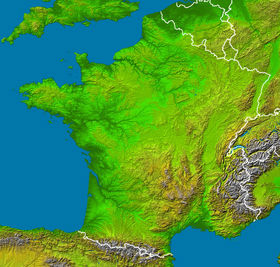

![]() A
complex set of conditions gives rise to a Mistral, but in
essence it is a kind of föhn wind. When a high-pressure
system sits over the plateau of the Massif Central, and
a low-pressure system sits over the Mediterranean
Sea, the cold mountain air will flow down the pressure
slope, accelerating as it roars through the gap of the Rhône
valley. You can see the Rhône valley clearly on the relief
map on the right - it runs north-south in between the two
big mountain ranges, the Massif Centrale to the west and
the Alps to the east.
A
complex set of conditions gives rise to a Mistral, but in
essence it is a kind of föhn wind. When a high-pressure
system sits over the plateau of the Massif Central, and
a low-pressure system sits over the Mediterranean
Sea, the cold mountain air will flow down the pressure
slope, accelerating as it roars through the gap of the Rhône
valley. You can see the Rhône valley clearly on the relief
map on the right - it runs north-south in between the two
big mountain ranges, the Massif Centrale to the west and
the Alps to the east.
Locals claim that a sudden feeling of dejection or even depression sweeps through them just before the Mistral comes. Once the wind arrives, depression gives way to headaches and irritability. In Provence it is widely believed that the Mistral always blows for an odd number of days. The name "mistral" comes from the Occitan (Provençal) word for "master". The wind masters the population, knocking people off balance physically and out of their minds emotionally (Remember the Mistral in Jean de Florette). The Occitan (Provençal) name of 'le vent du fada', translates as "the idiot wind".
A piercingly clear sky accompanies the wind. In the Vaucluse, in northern Provence, they claim that it is possible to see Corsica from the summit of Mont Ventoux during a Mistral. Off the coast, sea temperatures have generally dropped noticeably by the end of the first day of a Mistral. At sea, sailors fear the deadly combination of the wind and the poor visibility caused by spume whipped off the wave crests.
The name of this wind is also the surname of one of the greatest French poets, who wrote in Occitan and won the Nobel prize for literature in 1904: Frederic Mistral.






